Abstract
Purpose
The role of inflammation and fibrinolysis for the development of back pain and sciatica has been discussed. The aim of this study was to assess the relationship between markers of inflammation and fibrinolysis, to predict the outcome after surgery for lumbar disc herniation.
Methods
177 patients were recruited. High sensitive C-reactive protein (hsCRP), plasminogen activator inhibitor 1 (PAI-1), fibrinogen, and D-dimer were analyzed preoperatively. Visual analogue scale (VAS) for back and leg pain, Oswestry Disability Index (ODI), and EuroQol 5 Dimensions (EQ-5D) were assessed preoperatively and at 6 weeks, 6-, 12-, and 24- months postoperatively. Dichotomization was made at the median for the laboratory analyses, and between the worst quartile and the other three quartiles for the outcome variables. Logistic regression was used to determine the odds ratios (OR) and 95 % confidence intervals (CI).
Results
The associations between PAI-1 and outcome seemed to be most prominent at the 6 and 12-month follow-up. When being in the upper half of PAI-1, the OR for being in the worst quartile of VAS back pain 12 months postoperatively was 3.33 (1.56–7.10). The corresponding OR for VAS leg pain was 2.46 (1.18–5.10), for ODI 2.83 (1.35–5.94) and for EQ-5D 2.73 (1.30–5.75). The OR for hsCRP was 2.10 (1.03–4.29) for being in the worst quartile of VAS back pain. Fibrinogen or D-dimer was not associated with any outcome variable.
Conclusions
High PAI-1, a marker of fibrinolysis, was fairly consistently associated with poor outcome, while hsCRP, fibrinogen, and D-dimer were not.

Similar content being viewed by others
References
Jonsson B, Stromqvist B (1996) Clinical appearance of contained and noncontained lumbar disc herniation. J Spinal Disord 9(1):32–38
Stromqvist B et al (2013) Swespine: the Swedish spine register: the 2012 report. Eur Spine J 22(4):953–974
Olmarker K et al (1995) Inflammatogenic properties of nucleus pulposus. Spine (Phila Pa 1976) 20(6):665–669
Scuderi GJ et al (2009) Epidural interferon gamma-immunoreactivity: a biomarker for lumbar nerve root irritation. Spine (Phila Pa 1976) 34(21):2311–2317
Sugimori K et al (2003) High-sensitivity analysis of serum C-reactive protein in young patients with lumbar disc herniation. J Bone Joint Surg Br 85(8):1151–1154
Sturmer T et al (2005) Pain and high sensitivity C reactive protein in patients with chronic low back pain and acute sciatic pain. Ann Rheum Dis 64(6):921–925
Briggs MS et al (2013) Relations of C-reactive protein and obesity to the prevalence and the odds of reporting low back pain. Arch Phys Med Rehabil 94(4):745–752
Jayson MI (1989) Vascular damage, fibrosis, and chronic inflammation in mechanical back pain problems. Semin Arthritis Rheum 18(4 Suppl 2):73–76
Cooper RG et al (1991) The role of epidural fibrosis and defective fibrinolysis in the persistence of postlaminectomy back pain. Spine (Phila Pa 1976) 16(9):1044–1048
Iwaki T, Urano T, Umemura K (2012) PAI-1, progress in understanding the clinical problem and its aetiology. Br J Haematol 157(3):291–298
Ghosh AK, Vaughan DE (2012) PAI-1 in tissue fibrosis. J Cell Physiol 227(2):493–507
Castellino FJ, Ploplis VA (2005) Structure and function of the plasminogen/plasmin system. Thromb Haemost 93(4):647–654
Haaland AK et al (1992) Fibrinolytic activity as a predictor of the outcome of prolapsed intervertebral lumbar disc surgery with reference to background variables: results of a prospective cohort study. Spine 17(9):1022–1027
Schell E et al (2008) Stress biomarkers’ associations to pain in the neck, shoulder and back in healthy media workers: 12-month prospective follow-up. Eur Spine J 17(3):393–405
Zebouni LN et al (1993) Lack of evidence for abnormal fibrinolysis in chronic low back pain. Br J Rheumatol 32(2):132–134
Zanoli G, Stromqvist B, Jonsson B (2001) Visual analog scales for interpretation of back and leg pain intensity in patients operated for degenerative lumbar spine disorders. Spine (Phila Pa 1976) 26(21):2375–2380
Fairbank JC et al (1980) The Oswestry low back pain disability questionnaire. Physiotherapy 66(8):271–273
Copay AG et al (2008) Minimum clinically important difference in lumbar spine surgery patients: a choice of methods using the Oswestry Disability Index, Medical Outcomes Study questionnaire Short Form 36, and pain scales. Spine J 8(6):968–974
Burstrom K, Johannesson M, Diderichsen F (2001) Swedish population health-related quality of life results using the EQ-5D. Qual Life Res 10(7):621–635
Rannou F et al (2007) High-sensitivity C-reactive protein in chronic low back pain with vertebral end-plate Modic signal changes. Arthritis Rheum 57(7):1311–1315
Zhang YG et al (2014) MALDI-TOF-MS serum protein profiling for developing diagnostic models and identifying serum markers for discogenic low back pain. BMC Musculoskelet Disord 15:193
Geersing GJ et al (2014) Exclusion of deep vein thrombosis using the Wells rule in clinically important subgroups: individual patient data meta-analysis. BMJ 348:g1340
Almeida DB et al (2008) Outcome following lumbar disc surgery: the role of fibrosis. Acta Neurochir (Wien) 150(11):1167–1176
Ronnberg K et al (2008) Peridural scar and its relation to clinical outcome: a randomised study on surgically treated lumbar disc herniation patients. Eur Spine J 17(12):1714–1720
Ross JS et al (1996) Association between peridural scar and recurrent radicular pain after lumbar discectomy: magnetic resonance evaluation. ADCON-L European Study Group. Neurosurgery 38(4):855–861 discussion 861-3
Dullerud R et al (1998) Influence of fibrinolytic factors on scar formation after lumbar discectomy. A magnetic resonance imaging follow-up study with clinical correlation performed 7 years after surgery. Spine 23(13):1464–1469
Asselbergs FW et al (2007) Gender-specific correlations of plasminogen activator inhibitor-1 and tissue plasminogen activator levels with cardiovascular disease-related traits. J Thromb Haemost 5(2):313–320
Stromqvist F et al (2008) Gender differences in lumbar disc herniation surgery. Acta Orthop 79(5):643–649
Knutsson B, Michaelsson K, Sanden B (2013) Obesity is associated with inferior results after surgery for lumbar spinal stenosis: a study of 2633 patients from the Swedish spine register. Spine (Phila Pa 1976) 38(5):435–441
Rihn JA et al (2012) Does obesity affect outcomes of treatment for lumbar stenosis and degenerative spondylolisthesis? Analysis of the Spine Patient Outcomes Research Trial (SPORT). Spine (Phila Pa 1976) 37(23):1933–1946
Turan A et al (2011) Smoking and perioperative outcomes. Anesthesiology 114(4):837–846
Jansson KA et al (2005) Health-related quality of life in patients before and after surgery for a herniated lumbar disc. J Bone Joint Surg Br 87(7):959–964
Dewing CB et al (2008) The outcomes of lumbar microdiscectomy in a young, active population: correlation by herniation type and level. Spine (Phila Pa 1976) 33(1):33–38
Fairbank JC (2014) Why are there different versions of the Oswestry Disability Index? J Neurosurg Spine 20(1):83–86
Conflict of interest
The authors have no conflicts of interest
Author information
Authors and Affiliations
Corresponding author
Rights and permissions
About this article
Cite this article
Elkan, P., Sten-Linder, M., Hedlund, R. et al. Markers of inflammation and fibrinolysis in relation to outcome after surgery for lumbar disc herniation. A prospective study on 177 patients. Eur Spine J 25, 186–191 (2016). https://doi.org/10.1007/s00586-015-3998-7
Received:
Revised:
Accepted:
Published:
Issue Date:
DOI: https://doi.org/10.1007/s00586-015-3998-7




